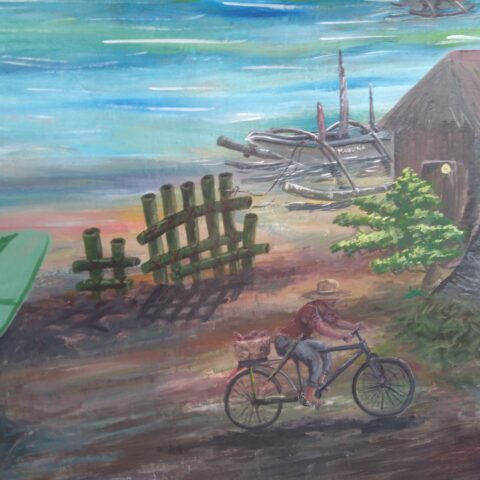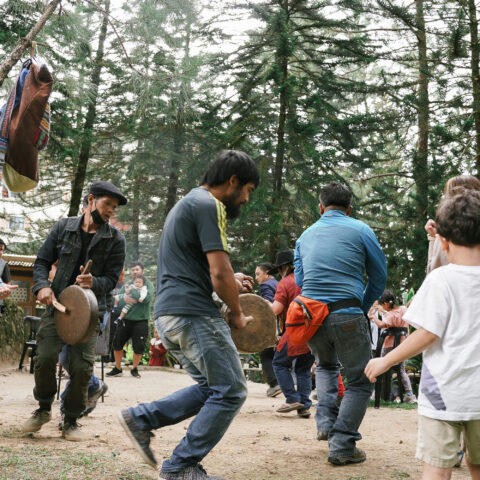By Padmapani Perez
First leap: three weeks back.
Spread out before us on a table are over 30 texts and photographs from Asia and the Pacific, Africa, and Latin America. To get here, we climb five flights of a narrow, wooden spiral staircase in an old apartment in Istanbul. Why are we even in this city?

Second leap: three months back from first leap.
When Alexandra Walter, Rehana Rossouw, Red Constantino, Ramon Sunico and I first gather in a house overlooking Taal volcano, it seems we were fated to meet, to challenge one another, to learn from each other, and to laugh, cry, and work on a book together.

Third leap: six years back from the present.
“Climate change – what does it mean to you and me? How do you figure in the picture? How real is it for me, for you, for your children?” Poets, journalists, anthropologists, scientists, teachers, and artists across the Philippines receive these questions along with a photograph and a list of jargon that we are not allowed to use. We are invited to write for a book on climate change. Typhoon Haiyan sweeps through the Philippines. The nation is grieving. I write a small poem that makes it into the book.

Fourth leap: one year forward from the third leap.
Agam: Filipino Narratives on Uncertainty and Climate Change is launched in 2014. It contains 26 images and 24 pieces in verse and prose, in eight Philippine languages including Waray, Sinama, Binisaya, Maguindanao, Ilokano, Bikol, Tagalog, and English. It wins awards. More importantly, it gains readers. (The poet Romulo Baquiran, himself a contributor, says of the other writers in the book: “Nasaniban sila.” They were possessed by the voices of the stories they wrote.) Most important of all, Agam: Filipino Narratives exists as a vehicle for climate conversations.

Fifth leap: a few months back.
Something else is sprouting from where Agam: Filipino Narratives was planted. A new literary anthology on climate change is growing. The youth are leading protests. They call for decisions and actions that will create a kinder future for all. They refuse to accept this damaged world we are passing on to them. A call goes out for contributions from photographers and writers in Africa, Asia and the Pacific, and Latin America. The Next Book, provisionally titled Agam International: Edges/borders/coasts is inspired by the youth and is a gift for the youth. It is a time bomb of love, memory and hope.

First leap:
We now have images from photographers such as Beatrice Velarde, Vinai Dithajohn, Masixole Feni and more from Peru, Chile, Colombia, Nepal, South Africa and the Philippines. Their images are writing prompts for poets, dreamers and schemers in Zimbabwe, South Africa, Nepal, Cuba, Colombia, Tanzania, Indonesia, the Marshalls, Argentina, Indonesia, Singapore, Botswana, Kenya, the Democratic Republic of Congo, Ecuador, Nigeria, China, Uruguay, Mexico, the Philippines, and Turkey. We need more. We are not being greedy. There are other voices that must be in the book.

Sixth leap: time bends.
What time is it in Colombia? What time is it in South Africa? What time is it in the Philippines? In Zimbabwe, the Marshalls, or Mexico? In India, New Zealand, or the Arctic Circle? Are the tides high or low? Are the glaciers thawing? Is it storming? Are the springs dry? Is it raining over the forests? Is it the time of the new moon? Are we on the edge of night or morning? A turtle begins a 6,396-kilometer swim from Erikub to Luzon.

First leap:
Istanbul is a city in which time becomes visible in mosaics, tesselations, and the ways in which the old and the new, the grand and the dingy live side by side. Alexandra, Rehana, and I walk down to the busy port where the Bosphorus whispers: Think of me (flowing), think of borders (disappearing), think of coasts (moving). All of these things we take in and put into Agam International. We think of you reading the Next Book.

Seventh leap: 2020.
When you turn the pages of Agam International: Edges/borders/coasts, what will it say to you?





